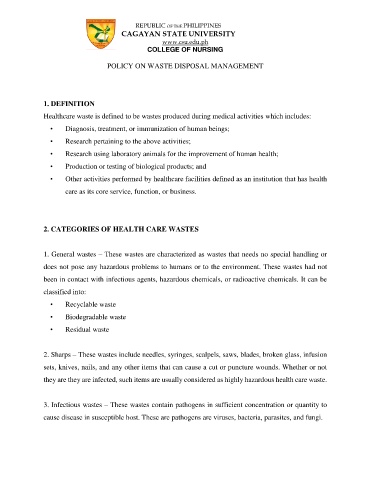Page 2288 - Documents for the COPC of BS Nursing Program
P. 2288
REPUBLIC OF THE PHILIPPINES
CAGAYAN STATE UNIVERSITY
www.csu.edu.ph
COLLEGE OF NURSING
POLICY ON WASTE DISPOSAL MANAGEMENT
1. DEFINITION
Healthcare waste is defined to be wastes produced during medical activities which includes:
• Diagnosis, treatment, or immunization of human beings;
• Research pertaining to the above activities;
• Research using laboratory animals for the improvement of human health;
• Production or testing of biological products; and
• Other activities performed by healthcare facilities defined as an institution that has health
care as its core service, function, or business.
2. CATEGORIES OF HEALTH CARE WASTES
1. General wastes – These wastes are characterized as wastes that needs no special handling or
does not pose any hazardous problems to humans or to the environment. These wastes had not
been in contact with infectious agents, hazardous chemicals, or radioactive chemicals. It can be
classified into:
• Recyclable waste
• Biodegradable waste
• Residual waste
2. Sharps – These wastes include needles, syringes, scalpels, saws, blades, broken glass, infusion
sets, knives, nails, and any other items that can cause a cut or puncture wounds. Whether or not
they are they are infected, such items are usually considered as highly hazardous health care waste.
3. Infectious wastes – These wastes contain pathogens in sufficient concentration or quantity to
cause disease in susceptible host. These are pathogens are viruses, bacteria, parasites, and fungi.

